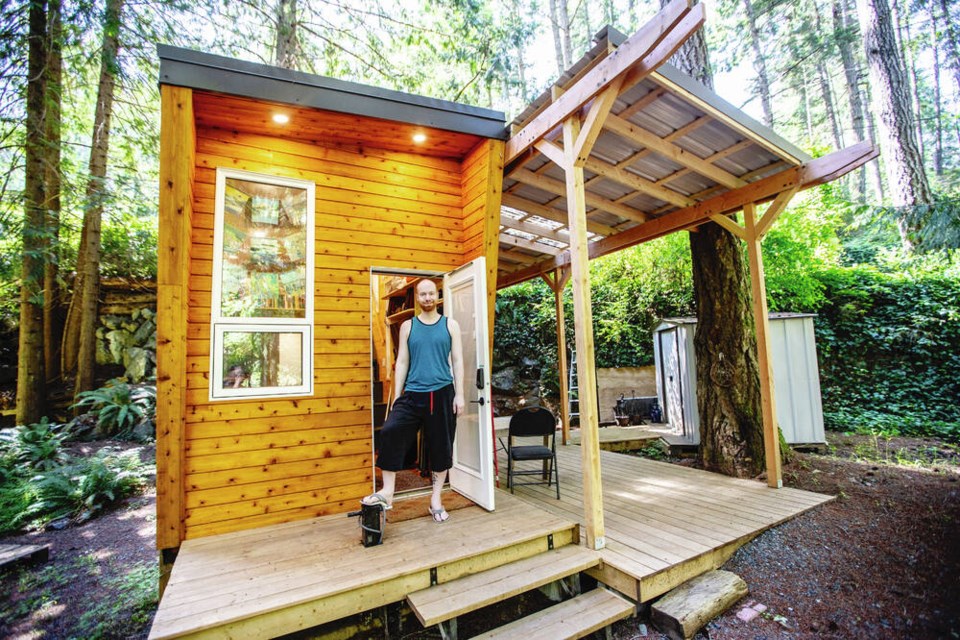Bryce Knudtson lives in a tiny home among tall cedar and fir trees next to a stream.
It’s an idyllic setting, quiet and peaceful and certainly affordable. He pays $650 a month for the pad, sewer and electrical hookups for the small house on wheels that he and his father built in Saskatoon two years ago.
Behind a cedar gate that closes to form a heart, Saige Lancaster, the owner of the two-acre Metchosin property just off Kangaroo Road, has created a micro-community of nine people living in three tiny homes on wheels, an RV and a converted bus.
Lancaster said with the ability to own or even rent a home out of reach for many people, providing an affordable place for housing, such as tiny homes, seemed like a great idea.
But on Aug. 31, Knudtson and the others are being evicted by the District of Metchosin.
Lancaster is contravening the district’s bylaws, which allow for one primary and one accessory dwelling per lot. She was initially given an eviction notice in January after Metchosin received a complaint.
Two extensions to explore options were granted, but the third was denied by the municipality and the Aug. 31 deadline was set.
“The district has been working with us with the extensions,” said Lancaster.
“I think they are happy to hear we are having water trucked in for cisterns on the property, not draining the aquifers, and compostable toilets. But we’ve kind of hit a wall here.”
Lancaster said she plans to take steps so at least one of her tenants — parents with a young child — can stay. But the other tenants will have to move.
Mayor John Ranns said he’s sympathetic to the plight of Lancaster’s tenants, but any question of whether to change the bylaw to allow extra homes will depend on the council elected in the Oct. 15 civic election, and he’s not optimistic. If anything, he said, residents are pushing the other way, wanting to keep the bylaw the way it is.
Ranns said one of the options council is considering is allowing trailer pads on properties, as an alternative to a secondary fixed home, but not both.
The mayor, who is in his eighth term as mayor and is not running again, said increasing densification brings a host of costly challenges, such as water, power, sewage and updated building codes. “It’s not as simple as changing the bylaw … there’s a lot to consider here.”
Lancaster is asking for an emergency measure to stave off the evictions until suitable housing can be found for her tenants, but that isn’t likely to happen.
Last June on Salt Spring Island, the Islands Trust passed a resolution that prevented action on illegal dwellings until there was more safe and affordable housing available.
Lancaster said she is writing letters to municipalities and regional districts around Vancouver Island to adopt similar policies and move toward friendlier bylaws that allow the placement of tiny homes and RVs.
“There is a housing crisis and this can be a solution to at least helping with some of the problem.”
Knudtson, who has worked as a receiver at Whole Foods for the past six years, doesn’t know where he’ll go. He said pads and places for tiny homes are few and far between in the CRD, and the few spots he’s found are over $1,000 a month and in the Malahat and Cowichan areas.
But he has to act fast, as Lancaster could face fines of up to $100 a day if the tenants aren’t out by the end of August.
“It’s been tough on everyone, said Knudtson. “We are a few families who are front-line and care workers, teachers, grocery-store employees and tradespeople.
“The truth is that none of us can afford rent or home ownership in Victoria or anywhere else on the Island during this recession and housing crisis.”
One of the group is moving to South America and another to Saskatchewan, said Knudtson. “But the rest of us are saddled with homes and debt, and can’t simply leave. This is an emergency situation and I have no idea what else to do.”
Knudtson said he had to have roommates to pay skyrocketing rents before he and his father built the tiny home on wheels. Now he’s losing sleep about putting his tiny home into storage or selling it and returning to a rental market considered one of most expensive in Canada.
A report last month by Rentals.ca indicated renters in Victoria would need to earn $55,000 to $85,000 a year, depending on location, to pay for a one-bedroom apartment.
Rentals.ca said the average one-bedroom in the region rents for $1,870 a month, up 14 per cent year over year, while a two-bedroom costs on average $2,900 a month, the third highest price for a two-bedroom in Canada after Vancouver and Toronto.
Lancaster and Knudtson have organized a social media group, B.C. Housing Crisis, and a petition calling on governments to act on affordable housing and place a moratorium on evictions from illegal dwellings.
“Families and individuals in the Capital Regional District are avoiding homelessness, finding safe and affordable housing in tiny homes and RV’s on private land,” they say. “This safe and affordable housing solution is currently illegal in every municipality of the CRD. So long as no one reports them, they will be safe. Some are speaking out while others are remaining quiet out of fear of homelessness. Many have already been reported. If action is not taken dozens of families and individuals will be evicted from their housing by the end of the summer.”



